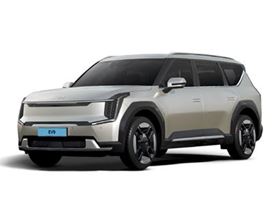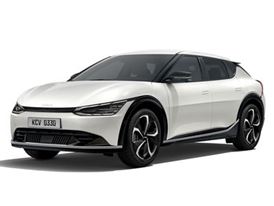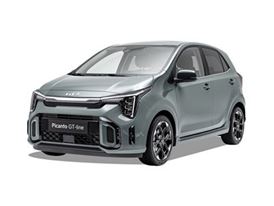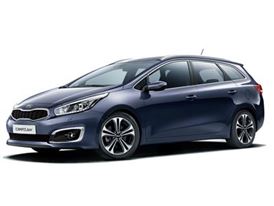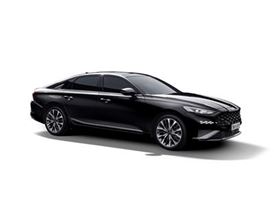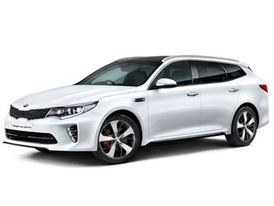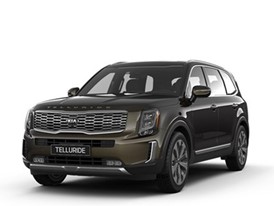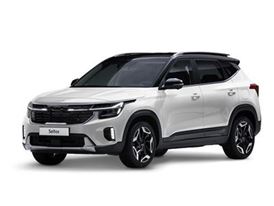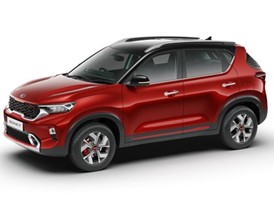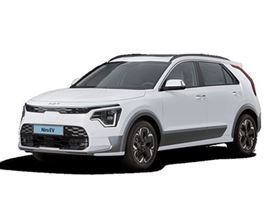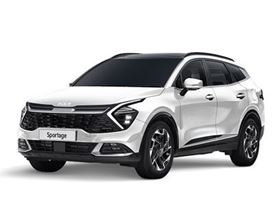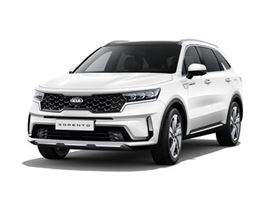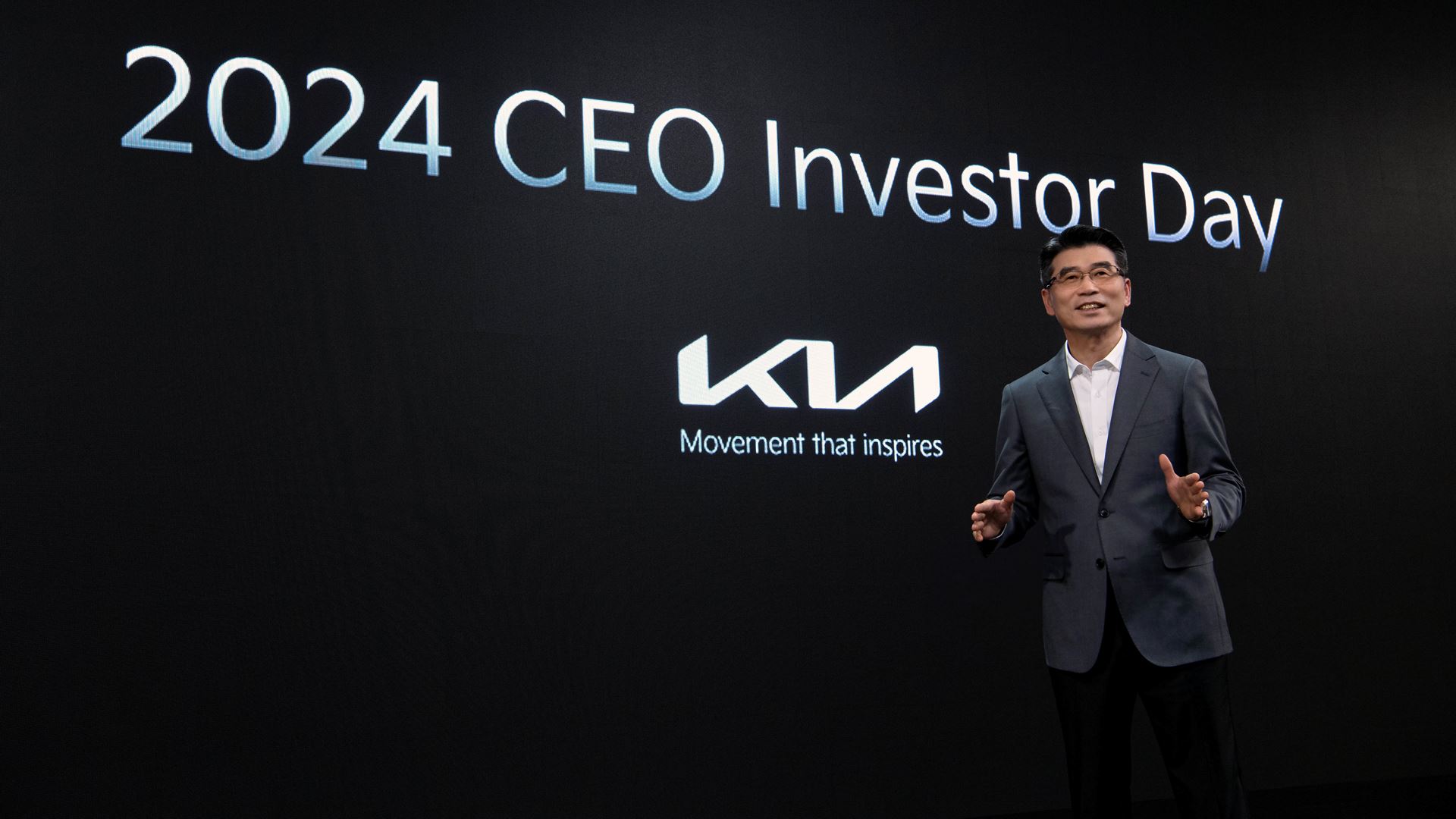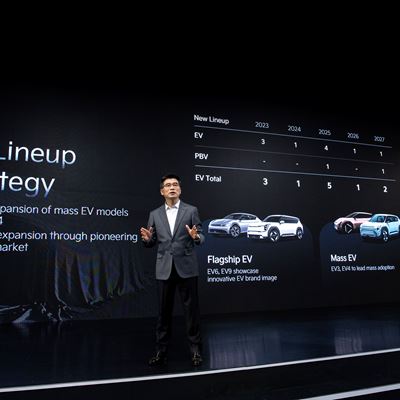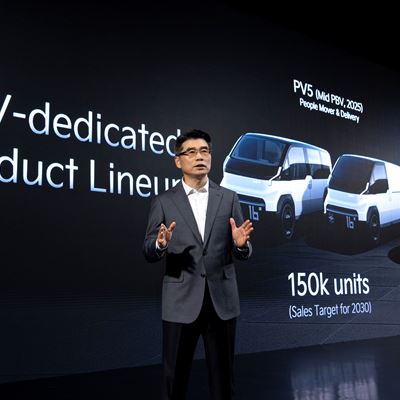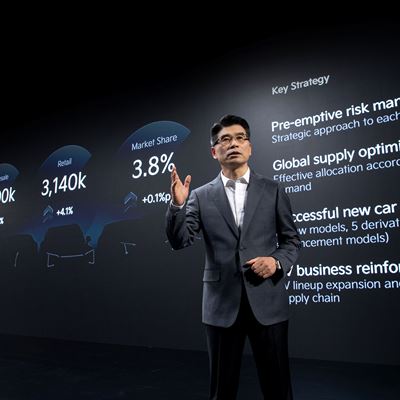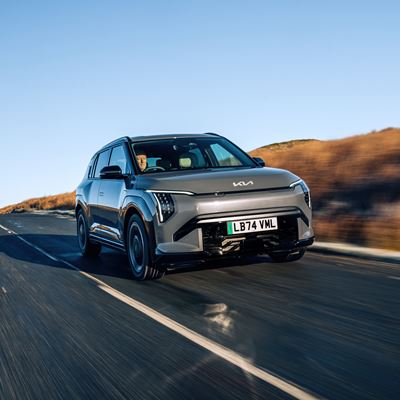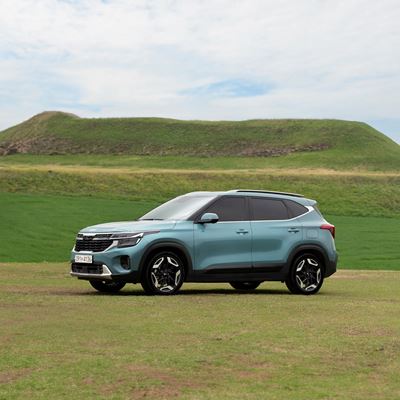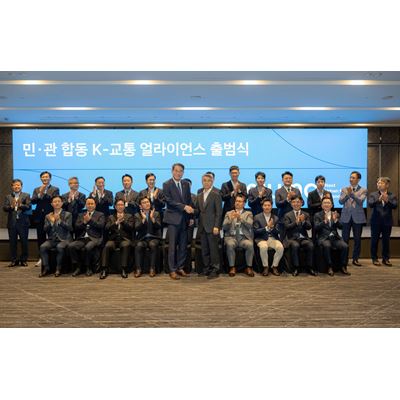2024 CEO Investor Day : Kia presents roadmap to lead global electrification era through EVs, HEVs and PBVs
- Kia drives forward transformation into 'Sustainable Mobility Solutions Provider'
- Roadmap enables Kia to proactively respond to uncertainties in mobility industry landscape, including changes in EV market
- Company to expand EV line-up with more models; enhance HEV line-up to manage fluctuation in EV demand
- Goal to sell 1.6 million EVs annually in 2030, introducing 15 models
- PBV to play a key role in Kia’s growth, targeting 250,000 PBV sales annually by 2030 with PV5 and PV7 models
- Kia to invest KRW 38 trillion by 2028, including KRW 15 trillion for future business
- 2024 business guidance : KRW 101 tln in revenue with KRW 12 tln in operating profit; operating profit margin of 11.9% on sales of 3.2 million units globally
- CEO reaffirms Kia’s commitment to ESG management
Kia Corporation (Kia) today shared an update on its future strategies and financial targets at its CEO Investor Day in Seoul, Korea.
Based on its innovative achievements in the years since the announcement of mid-to-long-term business initiatives, Kia is focusing on updating its 2030 strategy announced last year and further strengthening its business strategy in response to uncertainties across the global mobility industry landscape.
During the event, Kia updated its mid-to-long-term business strategy with a focus on electrification, and its PBV business. Kia reiterated its 2030 annual sales target of 4.3 million units, including 1.6 million units of electric vehicles (EVs). The 2030 4.3 million annual sales target is 34.4 percent higher than the brand’s 2024 annual goal of 3.2 million units.
The company also plans to become a leading EV brand by selling a higher percentage of electrified models among its total sales, including hybrid electric vehicles (HEV), plug-in hybrid (PHEV), and battery EVs, projecting electrified model sales of 2.48 million units annually or 58 percent of Kia’s total sales in 2030.
"Following our successful brand relaunch in 2021, Kia is enhancing its global business strategy to further the establishment of an innovative EV line-up and accelerate the company’s transition to a sustainable mobility solutions provider," said Ho Sung Song, Kia President and CEO. "By responding effectively to changes in the mobility market and efficiently implementing mid-to-long-term strategies, Kia is strengthening its brand commitment to the wellbeing of customers, communities, the global society, and the environment."
※ Summarized Investor Day
Counteractions to industry-wide uncertainties | |
Changes in EV market | • Strengthening HEV line-up : 6 models in 2024 → 8 models in 2026 → 9 models in 2028 • Expanding EV sales within its new line-ups, including EV2, EV3, EV4, EV5, and plans to produce both EVs and ICE vehicles at 13 factories globally |
The Rise of Chinese Brands | • Strengthening product competitiveness : applying OTA, ADAS technology • Establishing a global service system : 6,200 locations, 34,000 talented technicians • Entering new PBV markets : targeting B2B in addition to B2C • Utilizing Chinese factories for other emerging markets : 250,000 units in 2027 |
Accelerating Competition | • Maintaining proper inventory level through flexible production and operation • Providing innovative products to customers, enhancing user experience |
4 Core Goals for 2030 Strategy | |
Global Sales 4.3M units | • Annual sales target of 4.3M units by 2030 including 2.48M electrified models • Establishing full EV line-up, enhancing product competitiveness, creating new PBV demand • To differentiate the brand by enhanced high-quality customer experiences and respond to increasing demand by diversifying manufacturing bases. |
EV Strategy | • Expanding EV line-up to 15 models in 2027, targeting 1.6 million EV sales in 2030 • Improving battery performance and secure cost competitiveness • Driving a charging infrastructure expansion strategy worldwide (E-pit, IONNA JV, IONITY) |
PBV First Mover | • Annual sales goal of 250,000 PBVs in 2030 with Kia’s new PV5 and PV7 models – 150,000 and 100,000 units, respectively • Launching PV5 in 2025 and PV7 in 2027 • Producing the PBV models at EVO Plant in Korea and utilizing a flexible production system |
ESG Management | • Targeting RE100 renewable energy initiatives at the brand’s facilities worldwide - 66% by 2030, 82% by 2035, and 100% by 2040 |
2024 business goals / Mid-to long-term financial goals | |
2024 Business Goals | • 3.2 million wholesale units, 3.14 million retail sales, and a 3.8 percent market share • KRW 101 tln in revenue, KRW 12 tln in operating profit, and 11.9% operating profit margin • To introduce; - two new models : EV3 and K4 sedan - three product enhancement models : EV6, K8 sedan and Sportage SUV - two derivatives - K3 five-door and EV6 GT |
Financial Goals | • Mid-to-long-term operating profit margin goal of higher than 10% • Investment of KRW 38 trillion until 2028 to secure future competitiveness • To maintain dividend payout ratio at 20 to 35 percent based on net profit • To purchase shares up to KRW 500 billion every year for five years and cancel 50% of them |
Kia proactively responds to mobility industry-wide uncertainties
Kia took the opportunity to outline the measures it is taking to successfully navigate the main industry-wide changes expected to arise over the coming years: changes in the EV market, the rise of Chinese brands, and the alteration of the competitive environment.
① Strengthen electrified line-ups and flexible production for changes in the EV market
While the long-term EV demand for 2030 is expected to remain unchanged, the pace of demand growth may prove uneven in the near term. Factors such as a weaker global economic growth, reduction of EV subsidies, and slower adaption of charging infrastructure might affect EV demand.
To respond agilely to changes in the market environment, Kia will secure maximum flexibility in its line-up operation. Kia plans to strengthen its hybrid electric vehicle (HEV) line-up from six models in 2024 to nine models by 2028, with HEV powertrain options offered for most of the brand’s major models.
In response to EV market changes, Kia will launch six EV models by 2026, starting with the upcoming EV3 in 2024, followed by EV2, EV4, and EV5 in major markets, including the U.S., Europe, and South Korea. In emerging markets, the company will deploy two region-specified EVs, such as Carens EV for the Indian market.
The brand also plans to produce both EVs and internal combustion engine (ICE) vehicles at 13 factories globally, including seven in South Korea and six overseas. In addition, two EV-dedicated plants will be operated in South Korea.
② Competitive product and differentiated service against the rising Chinese brands
Kia also intends to pursue a multi-strand policy to counter the rise of Chinese competitor brands by strengthening its product competitiveness, establishing a global service and parts operation system, entering new PBV markets, and utilizing Chinese factories for other emerging markets.
Kia will strengthen its product and quality competitiveness in emerging markets, with plans to expand connected services to the Asia-Pacific, Middle East, and Central and South America regions, providing connected functionalities in 74 countries by 2026.
Kia plans to continue to strengthen the performance of its vehicles by expanding the number of models featuring over-the-air (OTA) technology to 18, and increasing the installation rate of advanced driver assistance systems (ADAS) to more than 63 percent of models by 2026.
This approach will be reinforced with customer service satisfaction improvements, such as a service capability utilizing 6,200 global locations and nearly 34,000 talented technicians, as well as the supply of customer-centered parts, and continued expansion of Kia’s digital services.
In addition, Kia plans to create new sales demand based on the innovation and flexibility of its PBV business. Kia will utilize its platform and flexible production system for PBVs in the B2B market, which requires vehicles for various business purposes, and to drive B2C demand.
The company will also utilize its Chinese plants to serve demand in emerging markets, which is expected to contribute 250,000 units in 2027.
③ Optimized and flexible business operation for competitive environment
Despite Kia’s continued growth, global vehicle demand still remains below pre-Covid levels, due largely to weakened purchasing power caused by high interest rates and inflation. Concurrently, many EV brands have invested aggressively to compete for lower prices.
Kia will respond to this situation first by maintaining a proper inventory level through flexible production and operation. Then, by managing the optimal incentive operation strategy with the best residual value, Kia will maximize value for its customers.
Furthermore, the brand will continue to provide innovative products to customers, enhancing the user experience. For example, generative AI technology will be deployed to provide in-vehicle AI voice services, making its debut later this year in the EV3 and K4.
Kia 2030 strategy : ‘Four core goals’
Kia will further solidify its 2030 strategy announced last year with four goals: global sales of 4.3 million units, sales of 1.6 million electric vehicles, pioneering PBV development, and responsible ESG management.
① 2030 annual global sales target of 4.3 million
Having previously announced an annual sales target of 4.3 million units by 2030, with electrified models accounting for 58 percent of the total range, Kia’s confidence in its award-winning products has led to the brand increasing its annual EV sales targets to 1.15 million units in 2027 and 1.6 million in 2030.
Kia plans to increase sales of electrified models to 2.48 million units, representing 58 percent of sales, in 2030, with 882,000 units of HEVs and PHEVs. This is a three-percentage point increase from last year's target and strengthens Kia’s strategy to change the sales structure with an even greater focus on electrified line-ups.
As demand for HEV is expected to continue, Kia plans to develop next-generation hybrid powertrains with improved performance, torque, and fuel efficiency, apply these advanced systems to various vehicle segments, and expand flexible production capabilities for both HEV and ICE models.
Kia plans to continue its growth momentum by building a full lineup of EVs in key markets, enhancing product competitiveness and creating new demand using PBVs. In addition, the company will differentiate the brand in emerging markets by enhanced high-quality customer experiences and respond to increasing demand by diversifying manufacturing bases.
② EV Strategy: Expanding to 15 EVs in 2027, targeting 1.6 million EV sales in 2030
Kia’s mid-to-long-term business strategy retains a focus on electrification and PBV growth, backed by a total of 15 EV models by 2027. This represents the addition of one more EV model to the 14 models previously committed to by the brand. This number includes new EVs – EV2, EV3, EV4 and EV5, and two PBVs – PV5 and PV7.
In addition, to improve battery performance and secure cost competitiveness, Kia plans to focus on upgrading its technology by enhancing the energy density and range offering of nickel-cobalt-manganese (NCM) batteries. The brand will also provide various battery options, including lithium iron phosphate (LFP) batteries, to meet the diverse needs of global markets.
Kia is also pushing a charging infrastructure expansion strategy around the globe. The brand plans to build more than 5,400 E-pit branded stations by 2030 in South Korea, with 482 currently installed. Kia is also targeting to utilize more than 30,000 charging stations in North America by 2030 as part of the IONNA joint venture. In Europe, the company will build more than 17,000 charging stations through its partnership with IONITY.
Product direction to achieve sales goals
Kia presents four directions of its products - connectivity, autonomous driving, performance, and design.
Kia plans to gradually expand new connectivity-based services, such as OTA, Feature on Demand (FoD), and in-car payment, to emerging markets. In addition, Kia plans to continue to improve its connectivity technologies based on the latest 5G network, such as advanced OTA systems and fuel efficiency driving using artificial intelligence (AI).
The company will also focus heavily on the expansion of software-defined vehicles (SDVs), with the development of an integrated platform that can maximize the synergy between system hardware and software and the combination of high-performance vehicle computers with high-speed connectivity and the latest artificial intelligence technologies to improve convenience and safety.
Kia is upgrading its highway driving assist (HDA) technology and plans to expand the system’s scope to autonomous driving in the cities by 2026 through the continuous development of high-resolution precision sensors and autonomous driving software.
Kia also plans to continue releasing GT trim variants of its EV models, including the EV9 GT, in January 2025. The brand plans to maximize the convenience and performance of its vehicles through OTA capability. This capability applies some of the latest software technologies, such as next-generation vehicle architecture, high-performance central computers, integrated operating systems, and controller-integrated software.
③ Becoming ‘PBV First Mover’ with diverse solutions
The 2024 CEO Investor Day event also provided a detailed blueprint for Kia’s PBV vision. Having launched its ‘Platform Beyond Vehicle’ business at CES 2024, the company has set an annual sales goal of 250,000 PBVs in 2030 with Kia’s new PV5 and PV7 models – 150,000 and 100,000 units, respectively.
Kia will launch its first PBV, the medium-sized PV5, in 2025, signaling the start of its PBV-related business. Following this, in 2027, the brand will launch the PV7, a large PBV that offers generous space within its PBV lineup.
This aim is underpinned by a flexible production system, dedicated PBV solutions for customers, and synergies with Hyundai Motor Group’s future businesses, including autonomous driving, robotics, and advanced air mobility (AAM).
④ Strengthening ESG Business Structure
Last year, Kia established its ESG vision named ‘Sustainable Movement for an Inspiring Future’. Centered around three core environmental, social and governance goals, the vision aims to build an eco-friendly manufacturing environment and strengthen the development of eco-friendly products. In addition, it will empower Kia to actively participate in solving global social issues, help build a society where everyone is safe and satisfied and establish transparent and reliable governance by practicing responsible management.
Focusing on the environment, Kia is fully aligned with RE100. The brand will replace all electricity demands at its workplaces worldwide with renewable energy, targeting 66 percent by 2030, 82 percent by 2035, and 100 percent by 2040. In particular, the 2030 and 2035 goals are raised by three and four percentage points, respectively, compared with the goals announced during CEO Investor Day 2023, which reflects Kia's commitment to lead on sustainability and the environment.
■ 2024 business goals and mid-to long-term financial goals
Kia announced its 2024 business plan based on optimizing global supply, launching new cars, and improving competitiveness in the EV business amid uncertain industrial demand growth in 2024.
Under this trend of subdued industrial demand growth, Kia has established its 2024 business plan with 3.2 million wholesale units, 3.14 million retail sales, and a 3.8 percent market share.
In 2024, Kia plans to introduce two new models - EV3 and K4 sedan, three product enhancement models - EV6, K8 sedan and Sportage SUV, and two derivatives - K3 five-door and EV6 GT. With the launch of the EV3, Kia will lead the popularization of EVs. With the successful launch of the K4 sedan, produced at the brand’s Mexico plant, Kia will continue its global sales momentum.
The company also announced its financial targets in 2024 of KRW 101 trillion in revenue, KRW 12 trillion in operating profit, and an 11.9 percent operating profit margin.
Kia presented its mid-to-long-term sustainable operating profit margin goal of higher than 10 percent through securing stable profit from HEVs and ICE vehicles, and EV cost competitiveness. From a long-term perspective, the company will create new sources of profitability from SDV business.
Kia also plans to continue its investment expansion to secure future competitiveness. It plans to invest KRW 38 trillion until 2028, a rise of KRW 5 trillion compared with last year’s announcement.
Additionally, Kia continues to implement its shareholder return policy to maximize shareholder value. As proposed last year, Kia plans to maintain its dividend payout ratio at 20 to 35 percent based on net profit, purchase shares up to KRW 500 billion every year for five years and cancel 50 percent of them.
The company will cancel an additional 50 percent of purchased shares in the case of the third quarter's cumulative financial target being achieved, particularly to expand shareholder returns and actively meet market expectations.
